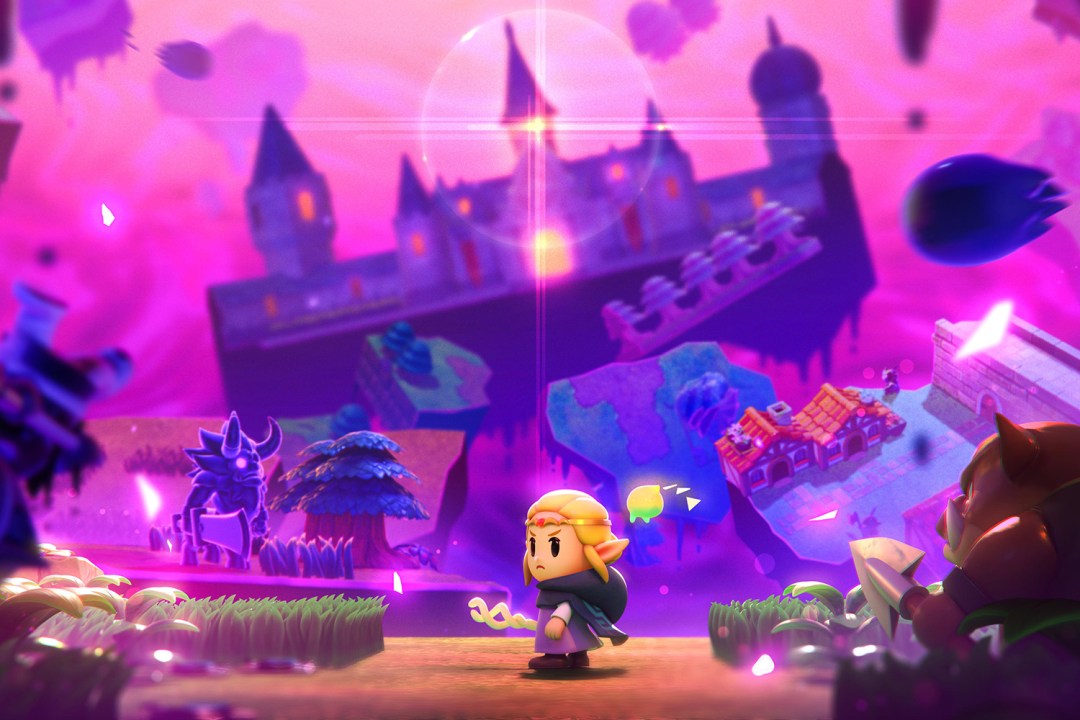Legend of Zelda: Echoes of Wisdom review – Tri cheers for the princess
We finally get to play as Princess Zelda in a Zelda game. Was it worth the wait?

Stuff Verdict
An absorbing blend of Zelda old and new, and a grand adventure worthy of a princess
Pros
- The Tri Rod turns 2D Zelda design on its head
- Lengthy and varied quest
- You get to play as Zelda!
Cons
- Some technical shortcomings
- Dungeons are mostly very easy
- UI can be a pain
It’s been a big year for Nintendo princesses. First Mario was given the day off as Peach quite literally took the stage in her first solo game for years, and now it’s Zelda’s turn. Despite having an entire series named after her, the princess of Hyrule has never been the playable protagonist – but that changes in The Legend of Zelda: Echoes of Wisdom.
After the gargantuan open-world epics of Breath of the Wild and Tears of the Kingdom, a return to the top-down 2D Zelda formula was something a lot of fans were asking for. But Echoes of Wisdom is anything but another A Link to the Past-esque throwback. In fact, you won’t be seeing much of Link at all.
Though naturally much smaller in scope than Tears of the Kingdom, the latest entry in Nintendo’s long-running series is undoubtedly inspired by that game more than the SNES and Game Boy classics of yesteryear. By equipping its star with a set of tools that would make Link and his Ultrahand jealous, The Legend of Zelda: Echoes of Wisdom weaves the open-ended, open-air design of the recent 3D Zeldas into the comfort blanket of the 2D games. And while it takes some getting used to, it’s a thrilling new direction for the series.
Link and you’ll miss him
Echoes of Wisdom opens as many Zelda games do. You’re Link, you’re wearing a green tunic, holding a sword, and fighting monsters. You know how these stories go. Or at least you used to. Because before you can say “ocarina”, the silent swordsman who always saves the day is sucked into a decidedly sinister-looking rift, along with much of Hyrule and its inhabitants.
Link’s out of the picture, then, but before disappearing he frees Zelda from the shiny gemstone she was trapped inside, and the quick-thinking princess manages to hotfoot it out of there before the rifts get her too. With her kingdom in turmoil, it falls to Zelda to find out what’s causing its sudden deformation and rescue those taken. This time, it’s a heroine that Hyrule needs.
After playing these games for 20-odd years, finding myself in control of Zelda for the first time felt strange. Almost like one of those fan projects that Nintendo moves swiftly to shut down. But it’s legit alright. While, like Link, she opts to let others do all the talking, there’s something very refreshing about Nintendo finally letting us see what it’s like to be in Zelda’s shoes when disaster befalls Hyrule.
Not that being the one who wears the crown makes Zelda’s task any easier. She initially has to don a hood to prevent the oblivious castle guards from noticing her and halting her quest, and as you start to explore the familiar regions of Hyrule it quickly becomes clear that nobody has any time for bowing before a royal when their village has vanished.
Tri’s company


In nearly every Zelda game, your most important tools are a sword and a shield, but The Legend of Zelda: Echoes of Wisdom is no ordinary Zelda. Shortly after her initial escape the princess meets a fairy called Tri, who gives her a magical staff called the Tri Rod. And you won’t be whacking anything with it. The Tri Rod allows Zelda to create “echoes”, or copies, of things she finds in the world, which she can then use to her advantage.
Early in the game you’ll acquire table echoes for reaching greater heights, then a trampoline for reaching, well, even greater heights. Beds can be stacked end-to-end to form makeshift bridges, while pots can be both throwable weapons and convenient hiding places. It’s all very playful in typical Nintendo fashion, with frequent “Aha!” moments when your strategy comes together.
And it isn’t just objects that you can make echoes of. The Tri Rod can do the same thing with monsters and Hyrule’s varied wildlife. Once you have an echo of a Boarblin you can make it do your fighting for you, spider echoes spin climbable webs and birds can carry you across gaps. In the early hours of the game you won’t go five minutes without gaining a new echo, and pretty soon you’ll have something in your arsenal for every situation.
Enemy in your way? An axe-wielding Darknut will happily cut it down for you, or you could blow it up with a Bombfish, or use a Wind Cannon to blow it into a chasm. Or just distract it with food. Echoes of Wisdom is constantly challenging you to think creatively, with even more solutions presenting themselves through the Bind ability, this game’s answer to TotK’s Ultrahand, which lets you manipulate objects or attach yourself to moving platforms or creatures, helping you get where you need to go.
It’s echoey in here


The myriad ways in which you can tackle puzzles and combat scenarios can take a while to sink in. For so long, Zelda games were about finding the exact solution to a carefully curated brain-teaser, but in Echoes of Wisdom the emphasis is once again on using your imagination. It’s less overwhelming than TotK, but not helped by the fact that every echo you add to your collection is located in one continuous horizontal toolbar, which I spent more time than I’d have liked scrolling from left to right and back again in order to find the one I wanted to use. You can sort by most used, which helps, but it’s not the most elegant UI.
It takes time, too, to adjust to the peculiarly hands-off rhythm of the combat. When I see a monster, my instinct is to rush at it with a sword, but Zelda’s approach is a more passive one. Fire your echo of choice and stand there looking at your watch until the fighting is finished. It doesn’t feel quite as classically heroic, which is probably why Nintendo does allow Zelda to transform into a sword-fighter in small bursts.
Push up on the d-pad and you’ll switch form, with the princess suddenly feeling a lot like Link. To ensure you can’t just ignore the central echo mechanic altogether, this ability consumes energy as you use it, and while this can be restored more quickly via upgrades, I often found myself hanging onto what energy I had for the tougher encounters.
In the opening stretch of the game I admittedly missed the old Zelda more than I expected to – why can’t I throw the boomerang? – but the more you expand your arsenal of echoes and experiment with different ideas, the more this innovative spin on a tried-and-tested formula begins to sink its teeth in. Eventually you’re able to cast more echoes simultaneously, so eventually you can run into bandit camps with a small army by your side and traverse the overworld with ease thanks to your assortment of climbable household furniture. When it all clicks, it’s great fun.
I’m still standing


Zelda’s quest spans the entirety of a Hyrule that feels surprisingly expansive for a 2D Zelda game. Think Breath of the Wild if it was reimagined as a Polly Pocket. You’ll travel to the territories of familiar races like the Gerudo, the Gorons and the Zora, exploring deserts, volcanoes and underwater villages. Fast travel points are plentiful, but the princess can also rent horses to get around. Echoes of Wisdom’s colourful toy-like visual style is reminiscent of the excellent Link’s Awakening remake and bursts with charm, but unfortunately frame rate and slowdown issues from that game are present here too, and at times I did wish the game looked a bit sharper. Time for that Switch 2, Nintendo.
Inspiration from the recent 3D entries can be seen everywhere, from the detailed map and the way side quests are added to your mission log, to the treasure chests you unlock as a reward for clearing out camps of enemies, and a cooking mini-game. Echoes of Wisdom lets you mix ingredients to create smoothies that restore health and give temporary stat boosts such as faster climbing, extra defence and elemental resistance. As the game is pretty easy most of the time, these felt less crucial than in BotW and TotK, but it’s exciting to see the 2D series evolving with its bigger brother.
When people say they miss the old Zelda, what they often mean is that they miss dungeons, of which those people will be glad to know that The Legend of Zelda: Echoes of Wisdom has plenty. To access them you enter the ‘Still World’ inside the rifts, where disconnected clumps of terrain float eerily in the air. Dungeons in Echoes of Wisdom are of the traditional lock-and-key variety, with floors often connected by 2D side-scrolling sections a la Link’s Awakening.
They’re all typically well designed, if mostly pretty linear affairs, rarely stumping me with what I was supposed to do next. And because all of your echoes and Tri Rod abilities are available to you in dungeons too, they become less about specific puzzle solutions than using everything at your disposal to find a workable one.
You’ll be amazed at how often a few trampolines and the bed bridge does the trick, and several times I found myself staring at a rock blocking my path before remembering that I could just yank it out of the way using Bind. Zelda purists might scoff at this, but while your abilities can make dungeons a bit on the easy side early on, eventually you will need to get creative. The same goes for bosses, which are usually most effectively downed using a combination of Tri Rod abilities and good old-fashioned sword attacks.
Legend of Zelda: Echoes of Wisdom verdict



The first The Legend of Zelda game dedicated to the legendary princess herself might look like a return to simpler times, but this is a meaty and ambitious game that dares to break the mould with 2D Zelda in the same way that Breath of the Wild did with the 3D series back in 2017.
You still fight baddies, complete errands for friendly village weirdos and puzzle your way through multi-floored dungeons, but traditional gameplay is upended by the Tri Rod abilities in favour of something more improvisational, with delightful (and often very funny) results.
It’s not perfect; the echoes system quickly becomes bloated, to the extent that I’d often default to a handful of my most-used monsters and objects to get off the menu screen more quickly. And as much as I enjoyed the generous helping of dungeons, Zelda’s extensive abilities ensure that overcoming them was never a huge challenge for most of the game.
But I can’t help but applaud Nintendo for continuing to take creative risks with its treasured IP, and after 38 years it really is about time we get to play as Zelda. It’s pretty clear that the 2D games have now joined the 3D entries in this boldly experimental new era for one of gaming’s most beloved series’, and whether we’re playing as Link or Zelda, in any dimension, I’m excited to see where it goes next.
Stuff Says…
An absorbing blend of Zelda old and new, and a grand adventure worthy of a princess
Pros
The Tri Rod turns 2D Zelda design on its head
Lengthy and varied quest
You get to play as Zelda!
Cons
Some technical shortcomings
Dungeons are mostly very easy
UI can be a pain



